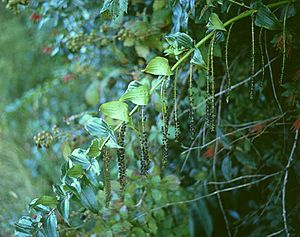Coriaria ruscifolia facts for kids
Quick facts for kids Coriaria ruscifolia |
|
|---|---|
 |
|
| Coriaria ruscifolia | |
| Scientific classification | |
| Kingdom: | |
| Division: | |
| Class: | |
| Order: | |
| Family: | |
| Genus: | |
| Species: |
C. ruscifolia
|
| Binomial name | |
| Coriaria ruscifolia |
|
| Synonyms | |
|
C. microphylla Poir. |
|
Coriaria ruscifolia is a type of shrub or small tree. It has bright red fruits that look a lot like berries. But be careful! Both the fruits and the leaves of this plant are very poisonous.
Contents
What are its Common Names?
This plant has many different names, especially in Latin America. Here are some of them:
- In Chile, people call it deu, dehue-lahuen, deó, hiuque, matarratones (which means "kill mice"), or veu.
- In Peru, it's known as mio-mio, saca-saca, mio venenosa, or raqui-raqui.
- In Ecuador, you might hear it called piñán, shanshi, shanchi, or zhanzhi.
- In Colombia, some names are reventadera, barbasco, chanchi, or mortiño borrachero.
- In Venezuela, it's known as tisís, helecho de playa, or helecho uvite.
- In Guatemala, people call it moco tinto or moco de chompipe.
- And in Mexico, it's sometimes called helecho de tierra, tlalocopetate, or tlalocopatlat.
How Scientists Classify This Plant
The plant Coriaria ruscifolia was first described by a famous scientist named Carl Linnaeus in 1753. He wrote about it in his book Species Plantarum. The plant he described came from Peru.
Scientists divide this plant into two main types, called subspecies:
- C. ruscifolia subsp. ruscifolia
- C. ruscifolia subsp. microphylla (Poir.) L. E. Skog
What Does Coriaria ruscifolia Look Like?
This plant is usually a shrub that can grow up to 4 meters (about 13 feet) tall. Its leaves are dark green on top and a lighter gray underneath.
The Flowers grow in groups at the ends of the side branches. They have green to red parts called sepals. The small petals are yellow or red, and the anthers (which hold pollen) are also yellow or red.
The Fruits look like berries, but they are actually small nuts. These nuts are covered by the petals of the flower.
One cool thing about the C. ruscifolia subsp. microphylla plants is that they can help the soil. They have special bacteria in their roots that can take nitrogen from the air. This process is called nitrogen fixation, and it helps the plant grow and makes the soil healthier.
Where Does It Grow?
Coriaria ruscifolia grows in many parts of the Americas and some Pacific Islands.
- The type called C. ruscifolia subsp. ruscifolia grows on the western slopes of the Andes mountains. You can find it from Mexico all the way down to Peru. It also grows in western Venezuela and in the cool mountains of New Guinea and New Zealand, as well as other Pacific islands.
- The other type, C. ruscifolia subsp. microphylla, is found in central and southern Chile, New Zealand, and other Pacific islands.
What Is It Used For?
This plant is very toxic, meaning it's harmful if eaten or touched without care. The fruits can affect the nervous system.
Even though it's poisonous, the leaves of Coriaria ruscifolia have something called tannin. This substance is used for tanning, which is a process of making leather from skins.
Sometimes, people also grow it as an ornamental plant because it looks nice.
In Chile, the fruits of this plant have been mixed with bread to help control mice and rats. However, it's very important to remember that this plant is dangerous for humans and pets too.
See also
 In Spanish: Coriaria ruscifolia para niños
In Spanish: Coriaria ruscifolia para niños

